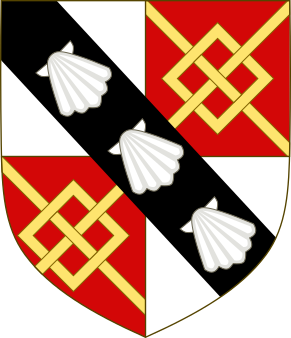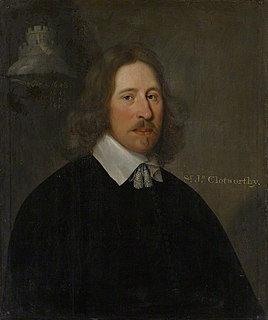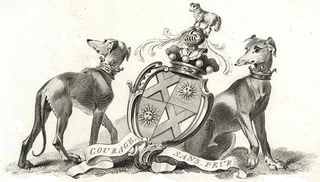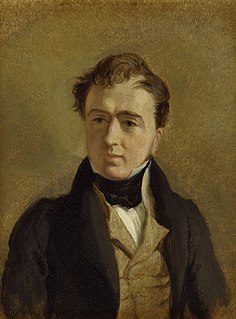Notes
This article includes a list of references, related reading or external links, but its sources remain unclear because it lacks inline citations .(November 2018) |
Baron Newlands, of Newlands and Barrofield in the County of the City of Glasgow and of Mauldslie Castle in the County of Lanark, was a title in the Peerage of the United Kingdom. It was created on 19 January 1898 for the soldier Sir William Hozier, 1st Baronet. He had already been created a baronet in the Baronetage of the United Kingdom in 1890. He was succeeded by his only son, the second Baron. He represented Lanarkshire South in the House of Commons and served as Lord-Lieutenant of Lanarkshire. Lord Newlands was childless and the titles became extinct on his death on 5 September 1929.
Sir Henry Montague Hozier (1838–1907), younger brother of the first Baron, was a Colonel in the 3rd Dragoons and the father of Clementine Churchill, wife of Winston Churchill (although Clementine's paternity has been the subject of some debate).
This article includes a list of references, related reading or external links, but its sources remain unclear because it lacks inline citations .(November 2018) |

The Spencer family is an aristocratic family in the United Kingdom. Founded in the 15th century, it has spawned numerous aristocratic titles including the dukedom of Marlborough, the earldoms of Sunderland and Spencer, and the Churchill barony. Two prominent members of the family during the 20th century were Sir Winston Churchill and Diana, Princess of Wales.

Earl of Rosebery is a title in the Peerage of Scotland created in 1703 for Archibald Primrose, 1st Viscount of Rosebery, with remainder to his issue male and female successively. Its name comes from Roseberry Topping, a hill near Archibald's wife's estates in Yorkshire. The current earl is Neil Primrose, 7th Earl of Rosebery.

Earl of Halifax is a title that has been created four times in British history—once in the Peerage of England, twice in the Peerage of Great Britain, and once in the Peerage of the United Kingdom. The name of the peerage refers to Halifax, West Yorkshire.

Earl of Limerick is a title that has been created twice in the Peerage of Ireland, associated first with the Dongan family, then with the Pery family.

Earl of Cottenham, of Cottenham in the County of Cambridge, is a title in the Peerage of the United Kingdom. It was created in 1850 for the prominent lawyer and Whig politician Charles Pepys, 1st Baron Cottenham. ) He served as Lord Chancellor from 1836 to 1841 and from 1846 to 1850. Pepys had already been created Baron Cottenham, of Cottenham in the County of Cambridge, in 1836, and was made Viscount Crowhurst, of Crowhurst in the County of Surrey, at the same time he was given the earldom. These titles are also in the Peerage of the United Kingdom. The viscountcy is used as a courtesy title for the Earl's eldest son and heir apparent.

Viscount Massereene is a title in the Peerage of Ireland. It was created in 1660, along with the subsidiary title of Baron Loughneagh. From 1665 to 1816 the Skeffington Baronetcy of Fisherwick was attached to the viscountcy and from 1756 to 1816 the Viscounts also held the title of Earl of Massereene. Since 1843 the peerages are united with titles of Viscount Ferrard, of Oriel and Baron Oriel, both in the Peerage of Ireland, and Baron Oriel, in the Peerage of the United Kingdom. The Viscount also holds the subsidiary titles of Baron Loughneagh (1660) and Baron Oriel (1790) in the Peerage of Ireland and Baron Oriel (1821) in the Peerage of the United Kingdom. As Baron Oriel, he sat in the House of Lords until 1999.

Viscount Gage, of Castle Island in the County of Kerry of the Kingdom of Ireland, is a title in the Peerage of Ireland. It was created in 1720 for Thomas Gage, along with the subsidiary title of Baron Gage, of Castlebar in the County of Mayo, also in the Peerage of Ireland. In 1744 he also succeeded his cousin as eighth Baronet, of Firle Place. The titles remain united. The Gage family descends from John Gage, who was created a baronet, of Firle Place in the County of Sussex, in the Baronetage of England on 26 March 1622. His great-grandson, the seventh Baronet, represented Seaford in Parliament. He was succeeded by his first cousin, Thomas Gage, 1st Viscount Gage, the eighth Baronet. He sat as a Member of Parliament for Minehead and Tewkesbury and also served as Governor of Barbados. In 1720, 24 years before succeeding in the baronetcy, he was raised to the Peerage of Ireland as Baron Gage and Viscount Gage. His second son was the military commander the Hon. Thomas Gage.

Viscount Wimborne, of Canford Magna in the County of Dorset, is a title in the Peerage of the United Kingdom.

Viscount St Davids, of Lydstep Haven in the County of Pembroke, is a title in the Peerage of the United Kingdom. It was created in 1918 for John Philipps, 1st Baron St Davids. The Philipps family descends from Sir John Philipps, who represented Pembrokeshire in the House of Commons. In 1621 he was created a Baronet, of Picton Castle in the County of Pembroke, in the Baronetage of England. His grandson, the third Baronet, also sat as Member of Parliament for Pembrokeshire. He was succeeded by his son, the fourth Baronet. He represented Pembroke and Haverfordwest in Parliament. His son, the fifth Baronet, sat for Haverfordwest. He was succeeded by his younger brother, the sixth Baronet. He represented Carmarthen, Petersfield and Pembrokeshire in the House of Commons.
Baron Hayter, of Chislehurst in the County of Kent, is a title in the Peerage of the United Kingdom. It was created in 1927 for the businessman Sir George Chubb, 1st Baronet. He had already been created a baronet of Newlands in the Baronetage of the United Kingdom in 1900. Chubb was chairman and managing director of the firm Chubb and Sons Lock and Safe Co Ltd, established by his grandfather Charles Chubb in the early 19th century. "Hayter" was the maiden name of George Hayter Chubb's mother, and was selected in preference to "Chubb", as it was not considered appropriate for names of corporations to be attributed to members of the House of Lords. He was succeeded by his son, the second baron. He was managing director of Chubb and Sons Lock and Safe Co Ltd. His son, the third baron, was managing director and chairman of Chubb and Sons Lock and Safe Co Ltd and also served as deputy chairman of the House of Lords from 1981 to 1995. As of 2014 the titles are held by the latter's son, the fourth baron, who succeeded in 2003.

Baron Northbrook, of Stratton in the County of Southampton, is a title in the Peerage of the United Kingdom. It was created in 1866 for the Liberal politician and former Chancellor of the Exchequer, Sir Francis Baring, 3rd Baronet. The holders of the barony represent the genealogically senior branch of the prominent Baring family. The name Northbrook is derived from a tithing of the local parish.

Baron Northbourne, of Betteshanger in the County of Kent, is a title in the Peerage of the United Kingdom. It was created in 1884 for Sir Walter James, 2nd Baronet, who had earlier represented Kingston upon Hull in the House of Commons as a Conservative. His son, the second Baron, sat as a Liberal Member of Parliament for Gateshead. The latter's great-grandson, the fifth Baron, who succeeded his father in 1982, was one of the ninety elected hereditary peers that were allowed to remain in the House of Lords after the passing of the House of Lords Act 1999, and sat as a cross-bencher until his retirement in 2018. As of 2019, the titles are held by his son, the sixth baron, who succeeded his father in that year.
Baron Moncreiff, of Tulliebole in the County of Kinross, is a title in the Peerage of the United Kingdom. It was created on 9 January 1874 for the lawyer and Liberal politician Sir James Moncreiff, 1st Baronet. He had already been created a Baronet, of Kilduff in the County of Kinross, in the Baronetage of the United Kingdom on 23 May 1871. In 1883 Lord Moncreiff also succeeded his elder brother as 11th Baronet, of Moncreiff in the County of Perth. On his death the titles passed to his eldest son, the second Baron. He was a Judge of the Court of Session from 1888 to 1905 under the title of Lord Wellwood and served as Lord Lieutenant of Kinross-shire between 1901 and 1909. He was succeeded by his younger brother, the third Baron. He was a clergyman. As of 2010 the titles are held by the latter's great-grandson, the sixth Baron, who succeeded his father in 2002.

Baron Milford is a title that has been created three times, once in the Peerage of Ireland and twice in the Peerage of the United Kingdom. All three creations have been for members of the same family. The first creation came in the Peerage of Ireland in 1776 when Sir Richard Philipps, 7th Baronet, of Picton Castle was made Baron Milford. However, this title became extinct on his death in 1823, while the baronetcy was passed on to a distant relative. The title was revived in the Peerage of the United Kingdom in 1847 when Sir Richard Philipps, 1st Baronet, of Picton Castle was created Baron Milford, of Picton Castle in the County of Pembroke. Born Richard Bulkeley Philipps Grant, he was the son of John Grant and Mary Philippa Artemisia, daughter of James Child and Mary Philippa Artemisia, daughter of Bulkeley Philipps, uncle of the first Baron of the first creation. He succeeded to the Philipps estates in 1823 and assumed the surname of Philipps the same year. In 1828 he was created a Baronet, of Picton Castle in the County of Pembroke, in the Baronetage of the United Kingdom. However, Lord Milford was childless and the titles became extinct on his death in 1857. He devised his estates to his half-brother Reverend James Henry Alexander Gwyther, who assumed the surname of Philipps. James's daughter Mary Philippa married Charles Edward Gregg Fisher, who assumed the surname of Philipps and was created a Baronet, of Picton, in 1887.

Baron Cottesloe, of Swanbourne and Hardwick in the County of Buckingham, is a title in the Peerage of the United Kingdom. It was created on 2 March 1874 for the Conservative politician and former Chief Secretary for Ireland, Sir Thomas Fremantle, 1st Baronet (1798–1890). He was the son of Admiral Sir Thomas Fremantle (1765–1819). Lord Cottesloe had already been created a Baronet, of Swanbourne in the County of Buckingham, on 14 August 1821, chiefly in recognition of his father's services, and with remainder to the latter's heirs. His father Sir Thomas Fremantle was created Baron Fremantle, of the Austrian Empire, which Lord Cottesloe inherited in 1819 with the death of his father. Subsequently, in 1822 he was given a Royal licence, which authorized him and his successors to use the title in Britain. However, a warrant issued on 27 April 1932 withdrew all the royal licences, only allowing the use of the title to the then current holders, their heir and their heir's heir. The fifth baron was the last holder being allowed to use the Austrian title in the United Kingdom.
Baron Athlumney, of Somerville and Dollarstown in the County of Meath, was a title in the Peerage of Ireland. It was created in 1863 for the Liberal politician Sir William Meredyth Somerville, 5th Baronet, who had previously served as Chief Secretary for Ireland. In 1866 he was also created Baron Meredyth, of Dollardstown in the County of Meath, in the Peerage of the United Kingdom. He was succeeded by his eldest and only surviving son from his second marriage, the second Baron. He was childless and on his death in 1929 the baronies became extinct while the baronetcy became dormant.

Baron Dufferin and Claneboye, of Ballyleidy and Killyleagh in County Down, Northern Ireland, is a title in the Peerage of Ireland. It was created 30 July 1800 for Dame Dorcas Blackwood, widow of Sir John Blackwood, 2nd Baronet, Member of the Irish Parliament for Killyleagh and Bangor, in return for support for the Union of Ireland and the United Kingdom.

Baron Colebrooke, of Stebunheath in the County of Middlesex, was a title in the Peerage of the United Kingdom. It was created in 1906 for Sir Edward Colebrooke, 5th Baronet. He held several positions at the British court. The Colebrooke family descended from the London banker James Colebrooke. His second son James Colebrooke represented Gatton in the House of Commons. On 12 October 1759 he was created a baronet, of Gatton in the County of Surrey, in the Baronetage of Great Britain, with remainder to his younger brother George. He was succeeded according to the special remainder by his younger brother George, the second Baronet. He was Member of Parliament for Arundel and also served as Chairman of the Honourable East India Company.
Hozier may refer to:
William Wallace Hozier, 1st Baron Newlands, known as Sir William Hozier, Bt, between 1890 and 1898, was a Scottish soldier and businessman.